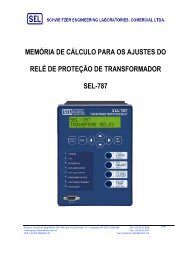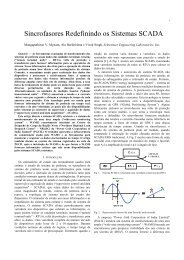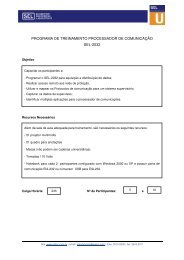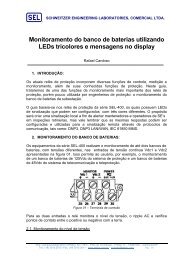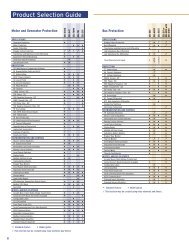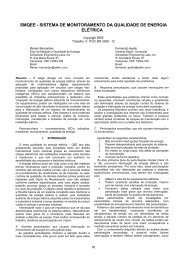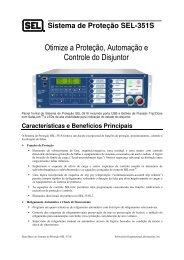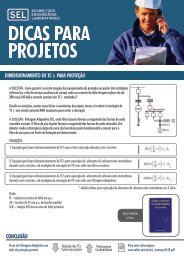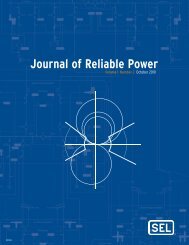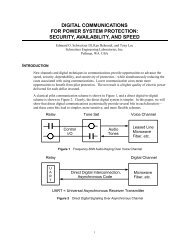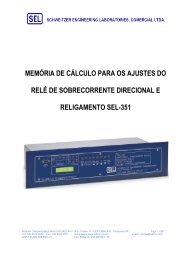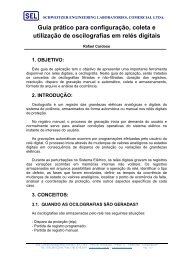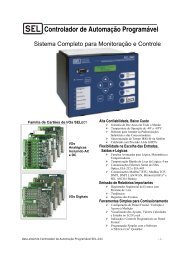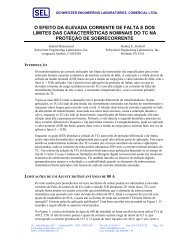Journal of Reliable Power - SEL
Journal of Reliable Power - SEL
Journal of Reliable Power - SEL
Create successful ePaper yourself
Turn your PDF publications into a flip-book with our unique Google optimized e-Paper software.
A. Simple Reactance Method<br />
From Figure 4, the voltage drop from the S end <strong>of</strong> the line<br />
is:<br />
VS = m • Z1L • IS + R F • IF<br />
(1)<br />
For an A-phase to ground fault, Vs = V a−g and I S = Ia + k • 3• I0<br />
The goal is to minimize the effect <strong>of</strong> the R F • IF<br />
term.<br />
The simple reactance method divides all terms by I S (I<br />
measured at the fault locator) and ignores the (R F •I F / I S ) term.<br />
To do this, save the imaginary part, and solve for m:<br />
( )<br />
Im V /I = Im(m • Z ) = m • X<br />
S S 1L 1L<br />
m =<br />
I<br />
m<br />
⎛ VS<br />
⎞<br />
⎜<br />
⎝ I ⎟<br />
⎠<br />
X<br />
1L<br />
Error is 0 if ∠ I = ∠ I or R = 0<br />
S<br />
S F F<br />
B. Takagi Method—One-Ended Impedance Method With No<br />
Source Data<br />
The Takagi method requires prefault and fault data. It<br />
improves upon the simple reactance method [2] by reducing<br />
the effect <strong>of</strong> load flow and minimizing the effect <strong>of</strong> fault<br />
resistance.<br />
VS = m • Z 1L • I + R F • IF<br />
(3)<br />
Use Superposition current (I sup ) to find a term in phase with<br />
I F :<br />
Isup<br />
= I − Ipre<br />
I = Fault Current<br />
(4)<br />
I = Pre-fault Current<br />
pre<br />
Voltage drop from Bus S:<br />
VS = m • Z 1L • IS + R F • IF<br />
Multiply both sides <strong>of</strong> equation (1) by the complex<br />
conjugate <strong>of</strong> I sup (I sup* ) and save the imaginary part. Then,<br />
solve for m:<br />
I m[VS • I sup* ] = m • I m (Z1L • IS • I sup* ) + R F • I m (IF • I sup* )<br />
I m (VS • I sup* )<br />
(5)<br />
m = I (Z • I • I )<br />
m 1L S sup*<br />
The key to the success <strong>of</strong> the Takagi method is that the<br />
angle <strong>of</strong> I S is the same as the angle <strong>of</strong> I F . For an ideal<br />
homogeneous system, these angles are identical. As the angle<br />
between I S and I F increases, the error in the fault location<br />
estimate increases.<br />
(2)<br />
C. Modified Takagi—Zero-Sequence Current Method with<br />
Angle Correction<br />
Another method (modified Takagi) uses zero-sequence<br />
current (3 • I 0S ) for ground faults instead <strong>of</strong> the superposition<br />
current. Therefore, this method requires no prefault data.<br />
Modified Takagi also allows for angle correction. If the<br />
user knows the system source impedances, the zero-sequence<br />
current can be adjusted by angle T to improve the fault<br />
location estimate for a given line.<br />
* − jT<br />
( ( ) )<br />
−<br />
( )<br />
Im V S • 3• I 0S • e<br />
m = (6)<br />
I Z • I • 3• I • e<br />
* jT<br />
( )<br />
m 1L S 0S<br />
The angle T selected will be valid for one fault location<br />
along the line. Figure 5 shows how to calculate T.<br />
Z 0S<br />
Figure 5<br />
known)<br />
3•I RS<br />
mZ 0L<br />
T<br />
3• I RS<br />
I F<br />
I F<br />
(1-m)Z 0L<br />
Zero-Sequence Current Angle Correction (if source impedances are<br />
IF<br />
Z0S + Z0L + Z0R<br />
= = A∠T<br />
3• I (1− m) • Z + Z<br />
RS 0L 0R<br />
D. Two-Ended Negative-Sequence Impedance Method<br />
A relatively new method, introduced in 1999, uses<br />
negative-sequence quantities from all line terminals for the<br />
location <strong>of</strong> unbalanced faults. By using negative-sequence<br />
quantities, we negate the effect <strong>of</strong> prefault load and fault<br />
resistance, zero-sequence mutual impedance, and zerosequence<br />
infeed from transmission line taps. Precise fault type<br />
selection is not necessary. Data alignment is not required<br />
because the algorithm employed at each line end uses the<br />
following quantities from the remote terminal (which do not<br />
require phase alignment).<br />
• Magnitude <strong>of</strong> negative-sequence current, I2<br />
• Calculated negative-sequence source impedance,<br />
Z ∠θ<br />
°<br />
2<br />
2<br />
Z 0R<br />
(7)<br />
Impedance-Based Fault Location Experience | 17



